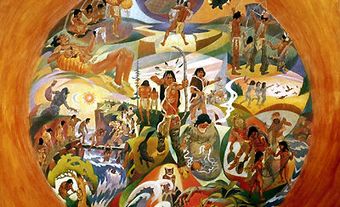The Handsome Lake Religion is a religion practised by some Haudenosaunee communities in Canada and the US. Its members are known as "the Longhouse people" because ceremonies are held in a longhouse. Its beliefs and practices are a blend of Indigenous traditions and innovations introduced by the Seneca prophet Handsome Lake who preached from 1799 until his death in 1815.
In Canada, the Handsome Lake Religion is represented on reserves at Kahnawake, Grand River, Oneida and St Regis. The religion is a combination of traditional Indigenous ceremonies and Christian messages about salvation and avoidance of sins. Abbreviated versions of the Gaiwiio, “the good words” or the Code of Handsome Lake, are recited at the Green Corn Festival in late August or early September and at the Midwinter Ceremonial in January or February. In the autumns of alternate years, the Gaiwiio is recited in full at a solemn convocation of the Six Nations (Haudenosaunee Confederacy) by designated speakers. Each speaker holds a bundle of wampum strings as their credentials, regalia acquired from their predecessors in office who taught them the Gaiwiio.
Member of the Handsome Lake Religion also perform other rites, such as the Great Feather Dance, the drinking of strawberry juice, commentaries on the Gaiwiio, and public confessions of moral lapses. Members may also attend other Indigenous religious rites and Christian churches. The teachings of Handsome Lake played an important role in reconstructing Haudenosaunee society.
See also Religion and Spirituality of Indigenous Peoples in Canada.

 Share on Facebook
Share on Facebook Share on X
Share on X Share by Email
Share by Email Share on Google Classroom
Share on Google Classroom
